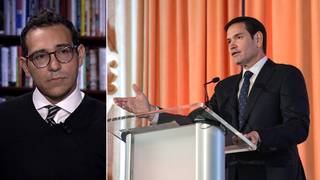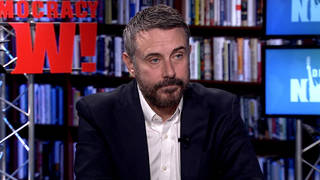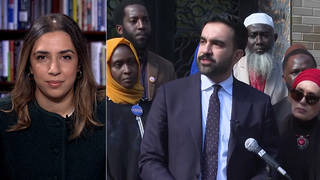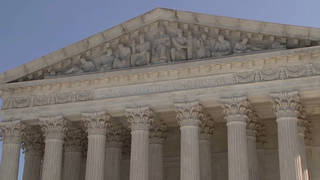
The Supreme Court is considering a North Carolina redistricting case that could have far-reaching implications for voting rights in the 2024 election and beyond. At stake in Moore v. Harper is whether North Carolina Republican lawmakers had the authority to overturn a state Supreme Court ruling that redrew the state’s congressional map due to partisan gerrymandering. The plaintiffs want the Supreme Court to embrace the notion of “independent state legislature theory,” a radical conservative reading of the Constitution that claims state lawmakers have sweeping authority to override courts, governors and state constitutions. “The stakes are really, really high,” says law professor Franita Tolson, who teaches at the University of Southern California Gould School of Law.
Transcript
AMY GOODMAN: This is Democracy Now!, democracynow.org. I’m Amy Goodman, with Nermeen Shaikh.
The Supreme Court heard arguments Wednesday in Moore v. Harper, a case with far-reaching implications for voting rights in the 2024 election and beyond. Justices considered a bid by North Carolina Republican lawmakers to overturn a state Supreme Court ruling that redrew North Carolina’s congressional map due to partisan gerrymandering. The plaintiffs want the Supreme Court to embrace the “independent state legislature theory,” which would hand state lawmakers sweeping authority to override courts, governors and state constitutions. The attorney Neal Katyal argued against the theory on behalf of North Carolina voting rights groups.
NEAL KATYAL: I’m not sure I’ve ever come across a theory in this court that would invalidate more state constitutional clauses as being federally unconstitutional, hundreds of them, from the founding to today. The blast radius from their theory would sow elections chaos, forcing a confusing two-track system with one set of rules for federal elections and another for state ones.
AMY GOODMAN: So, what is the independent state legislature theory? We’ll speak with a voting rights and constitutional law professor in a minute. First, this animated video from the Brennan Center for Justice.
NARRATOR: So, who protects your right to vote? Well, for more than 200 years, governors, state judges and state constitutions have played a critical role. When state legislatures tried to grab too much power, governors vetoed them, state courts struck them down, and state constitutions set important boundaries. These are the checks and balances that protect your vote.
But these guys are asking the Supreme Court to abandon that history, to eliminate checks on their power so they have nearly absolute control over elections. If they win, lawmakers in your state could eliminate voting by mail, early voting and automatic voter registration. They could set up endless barriers to prevent you from voting. And they could gerrymander you, making your vote meaningless — all to keep their party in power. And there would be nothing you could do about it. This is what the independent state legislature theory is all about.
AMY GOODMAN: For more, we’re joined by Franita Tolson, professor of law at USC — that’s University of Southern California — Gould School of Law.
Professor, welcome to Democracy Now! It’s great to have you with us.
FRANITA TOLSON: Good morning.
AMY GOODMAN: Explain what exactly was argued before the U.S. Supreme Court, and where the justices came down. Why are people saying this is the case that could upend democracy?
FRANITA TOLSON: So, yesterday’s argument was actually really, really important for the state of our democracy. What happened in the court below in Moore v. Harper is that the state Supreme Court found that a very gerrymandered congressional map that the state Legislature adopted in North Carolina violated the state Constitution’s free and fair election provision. And so, the state Legislature is arguing that this actually violates the elections clause. So, the independent state legislature theory provides that when state legislatures are exercising their authority under the elections clause to set the time, places and manner of federal elections, that they can do so free of the constraints of the state constitution, particularly as that document is interpreted by state supreme courts.
So, the stakes are really, really high, because, just from a practical standpoint, if a state legislature can operate free of state constitutional constraints, that means that, with respect to federal elections, they can remove a lot of the protections that state law provides for voters. A free and fair election provision is very important for ensuring that voters can exercise a right to vote that’s meaningful. And it also requires that there are certain protections for voters that remain in place. So, depending on how the justices come out, this case can have pretty substantial implications for our democracy.
AMY GOODMAN: So, let’s turn to the liberal Supreme Court Justice Elena Kagan speaking Wednesday during the oral arguments.
JUSTICE ELENA KAGAN: And in all these ways, I think what might strike a person is that this is a proposal that gets rid of the normal checks and balances on the way big governmental decisions are made in this country. And you might think that it gets rid of all those checks and balances at exactly the time when they are needed most, because legislators, we all know, have their own self-interest: They want to get reelected. And so, there are countless times when they have incentives to suppress votes, to dilute votes, to negate votes, to prevent voters from having true access and true opportunity to engage the political process.
AMY GOODMAN: So, that’s Supreme Court Justice Elena Kagan. Professor Tolson, talk about how these justices broke down yesterday. And give as a specific example of what kind of change, what kind of law could be instituted by legislatures, not wanted by the people.
FRANITA TOLSON: OK. So, the justices broke down — it actually wasn’t along a predictable line. So, you had fairly conservative justices, such as Justice Thomas and Justice Gorsuch, who seemed to kind of sign on to — and also Justice Alito, for that matter, who seemed to sign on to this idea that some version of this doctrine exists, and possibly the maximalist version, this idea that state courts should have no role in overseeing the state legislatures’ control of federal elections. So, it’s possible that those three justices could come down and find that, you know, that version of the independent state legislature theory should exist.
Then you had the more liberal justices, who think that the state courts should have a role. This is part of normal lawmaking. It’s not clear why state courts should not be a part of this process, particularly since all of the parties seem to accept that the governor can veto a plan, right? The governor is not part of the legislative body, and, instead, is exercising lawmaking power in this context. And why are excluding state courts from their ability to provide the normal oversight, which is a check on the state legislature, as well? So, you had the more liberal justices who seemed to sign on to the idea that the state courts should keep a role and that this doctrine — or, I’m sorry, this theory should have no place.
But there may be a compromise position here. So, the question for me, coming out of this oral argument, is: Where are Justices Kavanaugh, Coney Barrett and also the chief justice? They didn’t seem to really buy into this idea that state courts should have no role, although they did articulate some concerns with the positions articulated by the more liberal justices. So, for example, Justice Kavanaugh seemed to suggest that the chief justice — Chief Justice Rehnquist’s concurrence in Bush v. Gore, which resolved the 2000 presidential election, could potentially be a compromise position here. So, in that opinion, Chief Justice Rehnquist basically said that the state court should have a role, but if the state court departs substantially from state law, then that raises some concerns, right? That the federal court can come in and stop the state court from doing that. So, I think Justice Kavanaugh is seeing that as a compromise position that could work.
Justice Coney Barrett, for her part, she also seems skeptical of the state legislature’s argument that state courts should play no role. And in particular, the petitioners here, the state legislature, tried — they tried to argue that, “OK, if we have to say that state courts play a role, then state courts should not be able to police the substance of state regulations. Instead, they should be limited to just policing the procedure or the mechanism by which the state law is adopted.” And so, what that looks like here is that you have a gerrymandered plan, the state court cannot strike it down under the state constitution because that would be weighing in on the substance of the plan, but, alternatively, if there’s some procedural regulation that the state legislature has violated, perhaps the state court can then weigh in on that. Justice Coney Barrett seemed somewhat skeptical of this substance-procedure distinction, because oftentimes it’s very difficult to have a clear line between substance and procedure.
For example, Justice Sotomayor really honed in on this point. She gave the attorney for the state legislature this hypothetical where she’s basically like, “Look, what if you have a state constitutional provision that requires that redistricting plans be adopted in a special session, and the state legislature violates that and adopts the redistricting plan during a regular session? Is that a substantive decision if the state court strikes it down, or is it a procedural one?” Well, the attorney for the state legislature said that is a procedural decision. And that just seems really — no, I’m sorry, he said that it’s a substantive decision. And it seems really, really odd, because it’s clearly procedural. It has nothing to do with what’s in the plan; instead, it has something to do with how the plan is adopted. So, the substance-procedure distinction is just not a clear one. And I think Justice Coney Barrett really had a problem with that. So, it is entirely possible, coming out of this, you can have some version of the theory, but not necessarily the strong version of the theory that is arguably preferred by the more conservative justices.
AMY GOODMAN: Well, I want to thank you so much, Franita Tolson, for joining us and explaining this. I think, for most people, it sounds just like sort of a legal gobbledygook, but it absolutely has such a critical effect on voting in the United States, and we’ll continue to follow it. Professor Tolson teaches law at the University of Southern California Gould School of Law.
That does it for our show. On Friday, Democracy Now! co-host Juan González will be speaking at the CUNY School of Labor and Urban Studies at 3 p.m., and on Monday at 6:30 p.m. at the CUNY Graduate Center. He’ll be talking about the history of Latinos in America. Visit democracynow.org for all details. I look forward to seeing folks there as we all listen to Juan. I’m Amy Goodman, with Nermeen Shaikh. Thanks so much for joining us.












Media Options